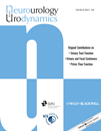Abstract
Aims
To compare the patient's response rate to the Percutaneous Nerve Evaluation test (PNE) and the 1st stage tined-lead placement test (FSTLP) for sacral neuromodulation therapy (SNM).
Methods
Single center study on patients with refractory idiopathic overactive bladder syndrome (OAB) or non-obstructive urinary retention, screened with both PNE and FSTLP. Patients were followed prospectively and their response rate based on bladder diary after PNE was compared to that after FSTLP. More than 50% improvement in at least two relevant urinary symptoms was considered a positive response. A Wilcoxon paired test was done to compare the rates of the two screening options and logistic regression to determine possible associations. A follow-up was conducted to determine the long-term failure rate.
Results
One hundred patients were included (82 female, 69 OAB). The mean age was 55 years (SD 13). The positive response rate on PNE was 47%. FSTLP showed a 69% positive response rate, which was negatively related to age. The 22% gain in positive response was statistically significant (P < 0.001) and positively associated with female gender and younger age. All 69 patients with a positive response to FSTLP received SNM treatment. Failure rate after an average of 2 years was 2.9%.
Conclusions
This study suggests that FSTLP may be a more sensitive screening method than PNE to identify patients eligible for SNM therapy, warranting randomized trials. Neurourol. Urodynam. 30:1249–1252, 2011. © 2011 Wiley-Liss, Inc.




